NBS8327: Networks & Strategies Impact on SMEs Internationalization
VerifiedAdded on 2023/06/13
|19
|4811
|233
Report
AI Summary
This report examines the impact of networks and strategies on the internationalization of Small and Medium Enterprises (SMEs). It highlights the importance of SMEs in global economic development and explores the challenges and opportunities they face when expanding internationally. The report analyzes the role of networking and strategic planning in facilitating successful internationalization, emphasizing the need for SMEs to develop clear strategies based on realistic assessments of their capabilities and the target market. It also identifies key barriers to internationalization, such as lack of experience, market information, and financial resources, while underscoring the potential benefits, including increased productivity, access to new technologies, and higher profitability. The report concludes by advocating for the development of supportive ecosystems that foster SME growth and international competitiveness, noting the importance of government policies and institutional support in promoting SME internationalization.
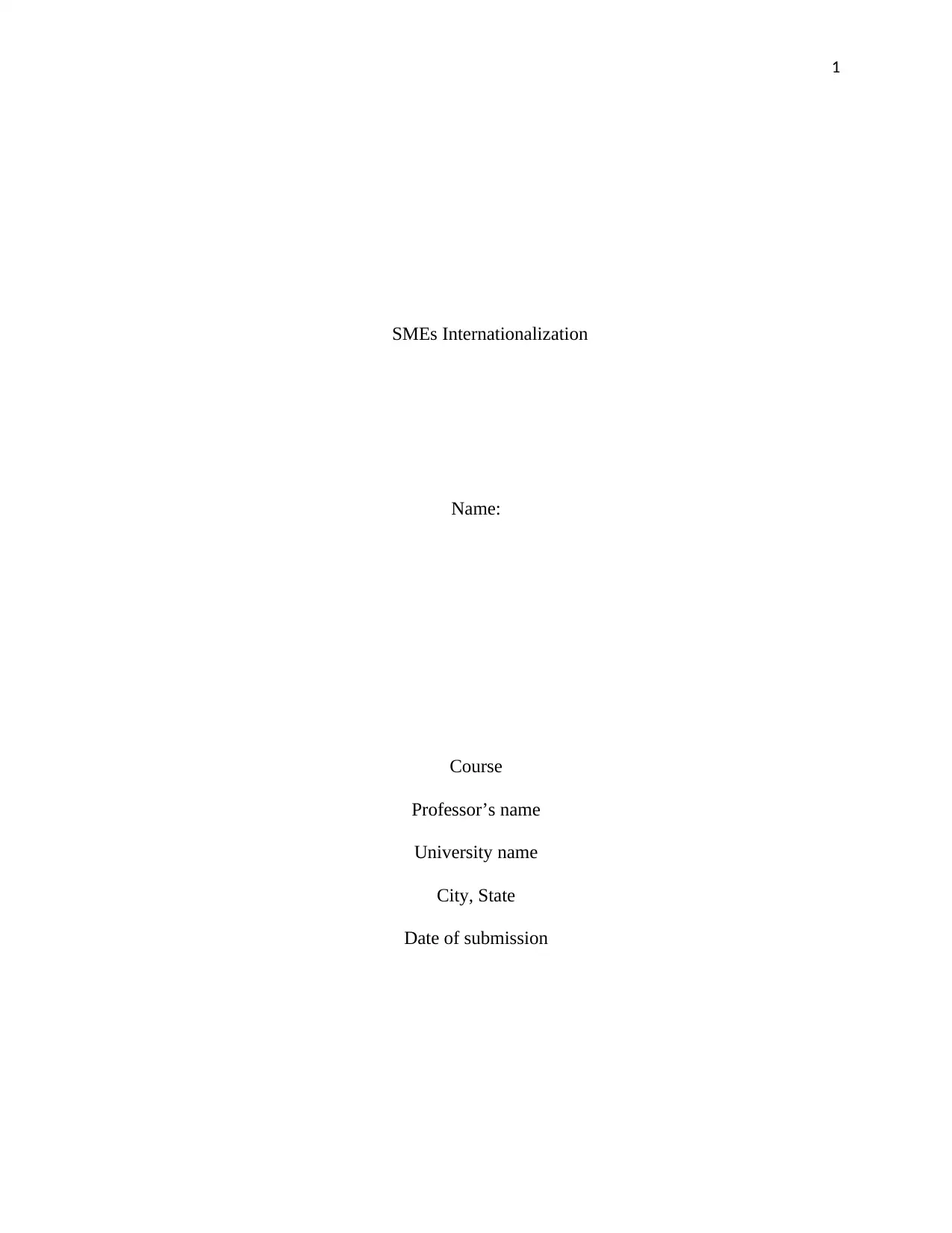
1
SMEs Internationalization
Name:
Course
Professor’s name
University name
City, State
Date of submission
SMEs Internationalization
Name:
Course
Professor’s name
University name
City, State
Date of submission
Paraphrase This Document
Need a fresh take? Get an instant paraphrase of this document with our AI Paraphraser
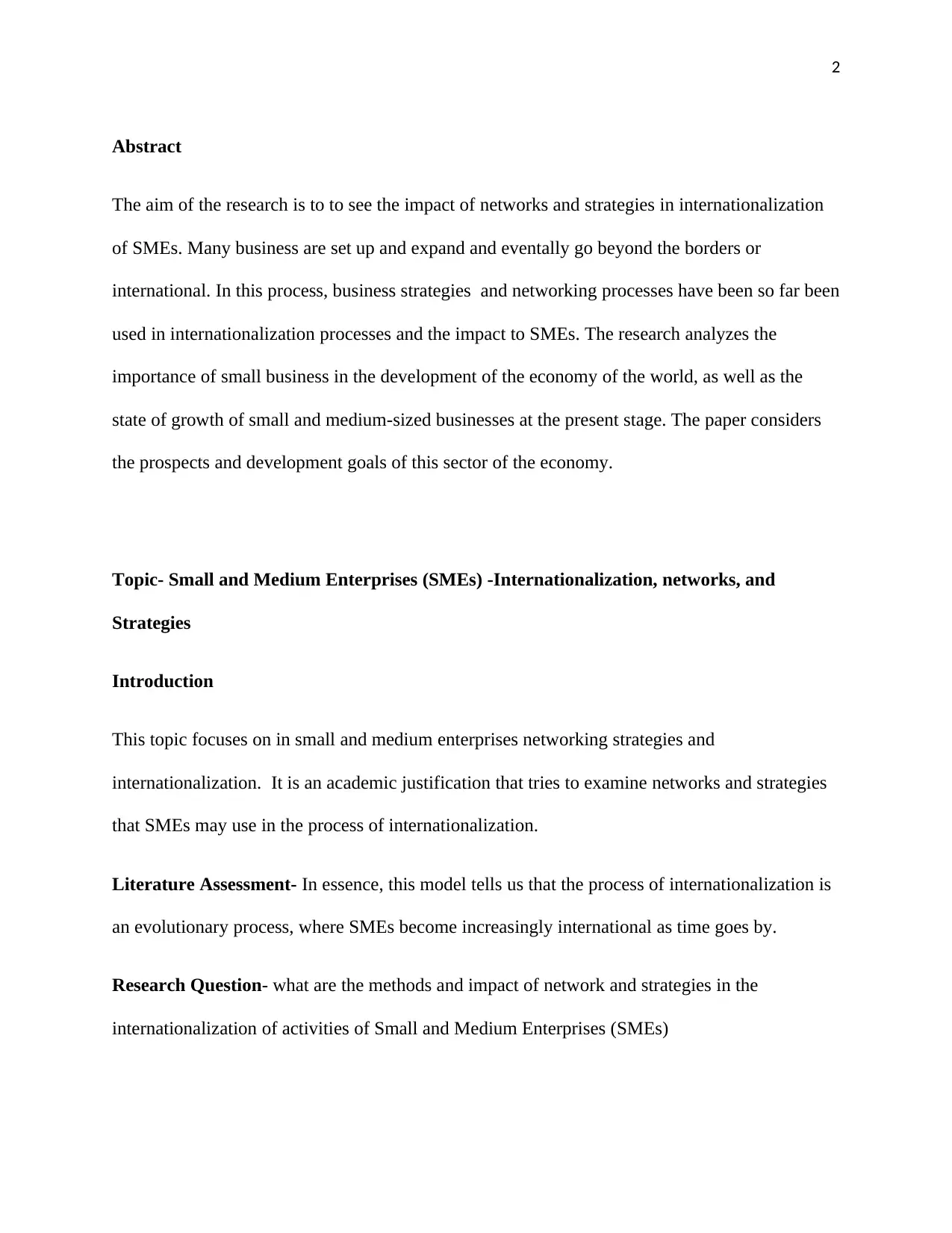
2
Abstract
The aim of the research is to to see the impact of networks and strategies in internationalization
of SMEs. Many business are set up and expand and eventally go beyond the borders or
international. In this process, business strategies and networking processes have been so far been
used in internationalization processes and the impact to SMEs. The research analyzes the
importance of small business in the development of the economy of the world, as well as the
state of growth of small and medium-sized businesses at the present stage. The paper considers
the prospects and development goals of this sector of the economy.
Topic- Small and Medium Enterprises (SMEs) -Internationalization, networks, and
Strategies
Introduction
This topic focuses on in small and medium enterprises networking strategies and
internationalization. It is an academic justification that tries to examine networks and strategies
that SMEs may use in the process of internationalization.
Literature Assessment- In essence, this model tells us that the process of internationalization is
an evolutionary process, where SMEs become increasingly international as time goes by.
Research Question- what are the methods and impact of network and strategies in the
internationalization of activities of Small and Medium Enterprises (SMEs)
Abstract
The aim of the research is to to see the impact of networks and strategies in internationalization
of SMEs. Many business are set up and expand and eventally go beyond the borders or
international. In this process, business strategies and networking processes have been so far been
used in internationalization processes and the impact to SMEs. The research analyzes the
importance of small business in the development of the economy of the world, as well as the
state of growth of small and medium-sized businesses at the present stage. The paper considers
the prospects and development goals of this sector of the economy.
Topic- Small and Medium Enterprises (SMEs) -Internationalization, networks, and
Strategies
Introduction
This topic focuses on in small and medium enterprises networking strategies and
internationalization. It is an academic justification that tries to examine networks and strategies
that SMEs may use in the process of internationalization.
Literature Assessment- In essence, this model tells us that the process of internationalization is
an evolutionary process, where SMEs become increasingly international as time goes by.
Research Question- what are the methods and impact of network and strategies in the
internationalization of activities of Small and Medium Enterprises (SMEs)
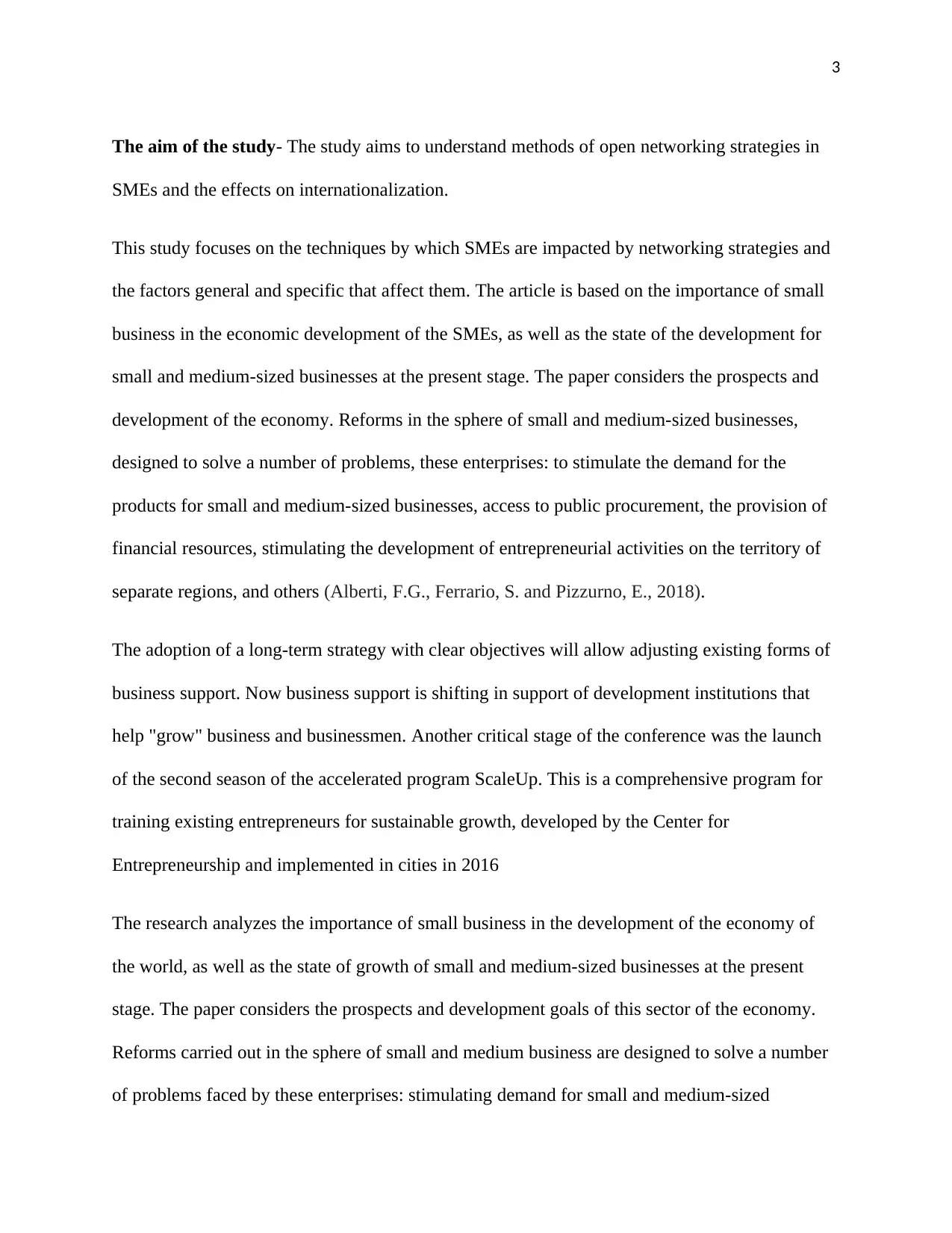
3
The aim of the study- The study aims to understand methods of open networking strategies in
SMEs and the effects on internationalization.
This study focuses on the techniques by which SMEs are impacted by networking strategies and
the factors general and specific that affect them. The article is based on the importance of small
business in the economic development of the SMEs, as well as the state of the development for
small and medium-sized businesses at the present stage. The paper considers the prospects and
development of the economy. Reforms in the sphere of small and medium-sized businesses,
designed to solve a number of problems, these enterprises: to stimulate the demand for the
products for small and medium-sized businesses, access to public procurement, the provision of
financial resources, stimulating the development of entrepreneurial activities on the territory of
separate regions, and others (Alberti, F.G., Ferrario, S. and Pizzurno, E., 2018).
The adoption of a long-term strategy with clear objectives will allow adjusting existing forms of
business support. Now business support is shifting in support of development institutions that
help "grow" business and businessmen. Another critical stage of the conference was the launch
of the second season of the accelerated program ScaleUp. This is a comprehensive program for
training existing entrepreneurs for sustainable growth, developed by the Center for
Entrepreneurship and implemented in cities in 2016
The research analyzes the importance of small business in the development of the economy of
the world, as well as the state of growth of small and medium-sized businesses at the present
stage. The paper considers the prospects and development goals of this sector of the economy.
Reforms carried out in the sphere of small and medium business are designed to solve a number
of problems faced by these enterprises: stimulating demand for small and medium-sized
The aim of the study- The study aims to understand methods of open networking strategies in
SMEs and the effects on internationalization.
This study focuses on the techniques by which SMEs are impacted by networking strategies and
the factors general and specific that affect them. The article is based on the importance of small
business in the economic development of the SMEs, as well as the state of the development for
small and medium-sized businesses at the present stage. The paper considers the prospects and
development of the economy. Reforms in the sphere of small and medium-sized businesses,
designed to solve a number of problems, these enterprises: to stimulate the demand for the
products for small and medium-sized businesses, access to public procurement, the provision of
financial resources, stimulating the development of entrepreneurial activities on the territory of
separate regions, and others (Alberti, F.G., Ferrario, S. and Pizzurno, E., 2018).
The adoption of a long-term strategy with clear objectives will allow adjusting existing forms of
business support. Now business support is shifting in support of development institutions that
help "grow" business and businessmen. Another critical stage of the conference was the launch
of the second season of the accelerated program ScaleUp. This is a comprehensive program for
training existing entrepreneurs for sustainable growth, developed by the Center for
Entrepreneurship and implemented in cities in 2016
The research analyzes the importance of small business in the development of the economy of
the world, as well as the state of growth of small and medium-sized businesses at the present
stage. The paper considers the prospects and development goals of this sector of the economy.
Reforms carried out in the sphere of small and medium business are designed to solve a number
of problems faced by these enterprises: stimulating demand for small and medium-sized
⊘ This is a preview!⊘
Do you want full access?
Subscribe today to unlock all pages.

Trusted by 1+ million students worldwide
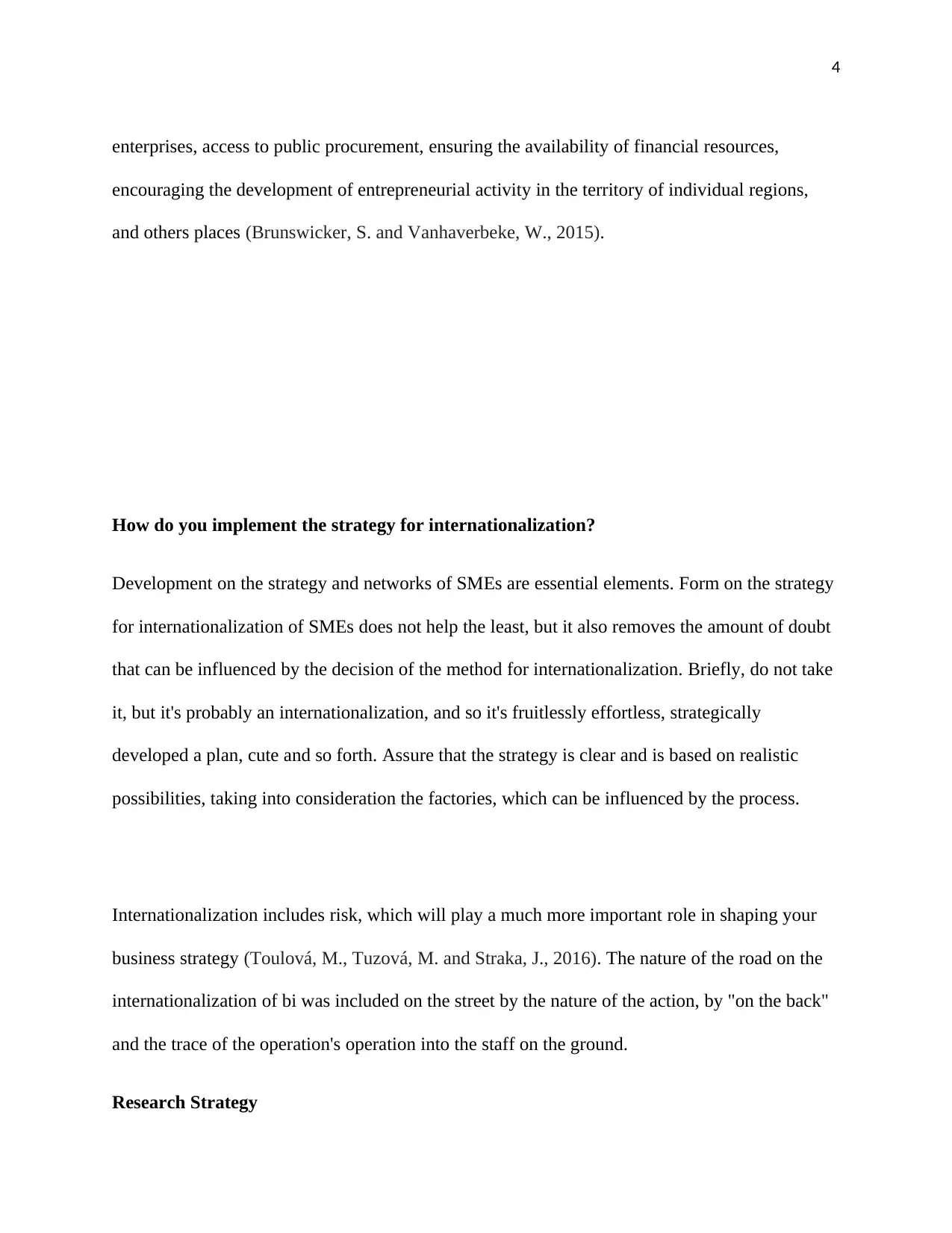
4
enterprises, access to public procurement, ensuring the availability of financial resources,
encouraging the development of entrepreneurial activity in the territory of individual regions,
and others places (Brunswicker, S. and Vanhaverbeke, W., 2015).
How do you implement the strategy for internationalization?
Development on the strategy and networks of SMEs are essential elements. Form on the strategy
for internationalization of SMEs does not help the least, but it also removes the amount of doubt
that can be influenced by the decision of the method for internationalization. Briefly, do not take
it, but it's probably an internationalization, and so it's fruitlessly effortless, strategically
developed a plan, cute and so forth. Assure that the strategy is clear and is based on realistic
possibilities, taking into consideration the factories, which can be influenced by the process.
Internationalization includes risk, which will play a much more important role in shaping your
business strategy (Toulová, M., Tuzová, M. and Straka, J., 2016). The nature of the road on the
internationalization of bi was included on the street by the nature of the action, by "on the back"
and the trace of the operation's operation into the staff on the ground.
Research Strategy
enterprises, access to public procurement, ensuring the availability of financial resources,
encouraging the development of entrepreneurial activity in the territory of individual regions,
and others places (Brunswicker, S. and Vanhaverbeke, W., 2015).
How do you implement the strategy for internationalization?
Development on the strategy and networks of SMEs are essential elements. Form on the strategy
for internationalization of SMEs does not help the least, but it also removes the amount of doubt
that can be influenced by the decision of the method for internationalization. Briefly, do not take
it, but it's probably an internationalization, and so it's fruitlessly effortless, strategically
developed a plan, cute and so forth. Assure that the strategy is clear and is based on realistic
possibilities, taking into consideration the factories, which can be influenced by the process.
Internationalization includes risk, which will play a much more important role in shaping your
business strategy (Toulová, M., Tuzová, M. and Straka, J., 2016). The nature of the road on the
internationalization of bi was included on the street by the nature of the action, by "on the back"
and the trace of the operation's operation into the staff on the ground.
Research Strategy
Paraphrase This Document
Need a fresh take? Get an instant paraphrase of this document with our AI Paraphraser
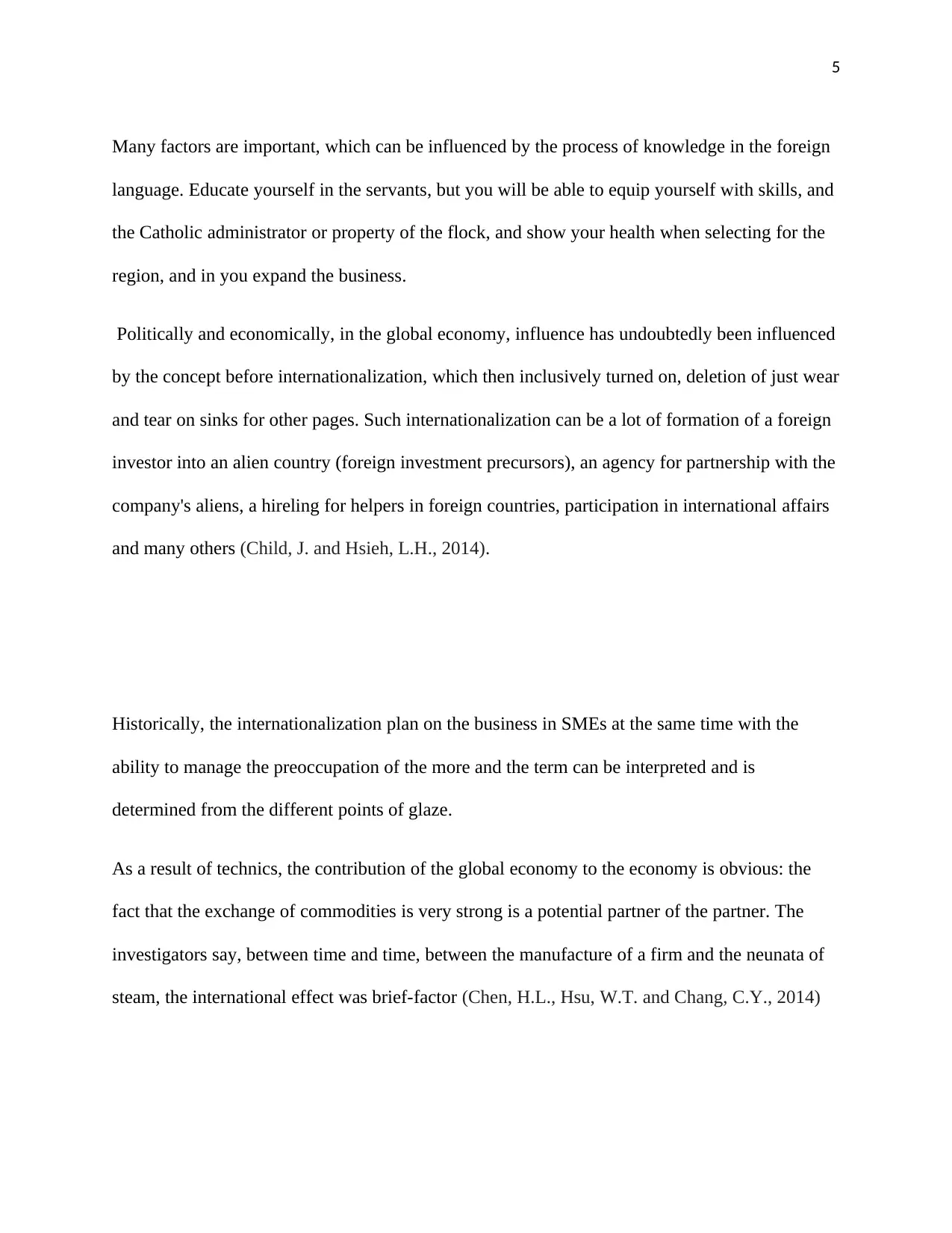
5
Many factors are important, which can be influenced by the process of knowledge in the foreign
language. Educate yourself in the servants, but you will be able to equip yourself with skills, and
the Catholic administrator or property of the flock, and show your health when selecting for the
region, and in you expand the business.
Politically and economically, in the global economy, influence has undoubtedly been influenced
by the concept before internationalization, which then inclusively turned on, deletion of just wear
and tear on sinks for other pages. Such internationalization can be a lot of formation of a foreign
investor into an alien country (foreign investment precursors), an agency for partnership with the
company's aliens, a hireling for helpers in foreign countries, participation in international affairs
and many others (Child, J. and Hsieh, L.H., 2014).
Historically, the internationalization plan on the business in SMEs at the same time with the
ability to manage the preoccupation of the more and the term can be interpreted and is
determined from the different points of glaze.
As a result of technics, the contribution of the global economy to the economy is obvious: the
fact that the exchange of commodities is very strong is a potential partner of the partner. The
investigators say, between time and time, between the manufacture of a firm and the neunata of
steam, the international effect was brief-factor (Chen, H.L., Hsu, W.T. and Chang, C.Y., 2014)
Many factors are important, which can be influenced by the process of knowledge in the foreign
language. Educate yourself in the servants, but you will be able to equip yourself with skills, and
the Catholic administrator or property of the flock, and show your health when selecting for the
region, and in you expand the business.
Politically and economically, in the global economy, influence has undoubtedly been influenced
by the concept before internationalization, which then inclusively turned on, deletion of just wear
and tear on sinks for other pages. Such internationalization can be a lot of formation of a foreign
investor into an alien country (foreign investment precursors), an agency for partnership with the
company's aliens, a hireling for helpers in foreign countries, participation in international affairs
and many others (Child, J. and Hsieh, L.H., 2014).
Historically, the internationalization plan on the business in SMEs at the same time with the
ability to manage the preoccupation of the more and the term can be interpreted and is
determined from the different points of glaze.
As a result of technics, the contribution of the global economy to the economy is obvious: the
fact that the exchange of commodities is very strong is a potential partner of the partner. The
investigators say, between time and time, between the manufacture of a firm and the neunata of
steam, the international effect was brief-factor (Chen, H.L., Hsu, W.T. and Chang, C.Y., 2014)
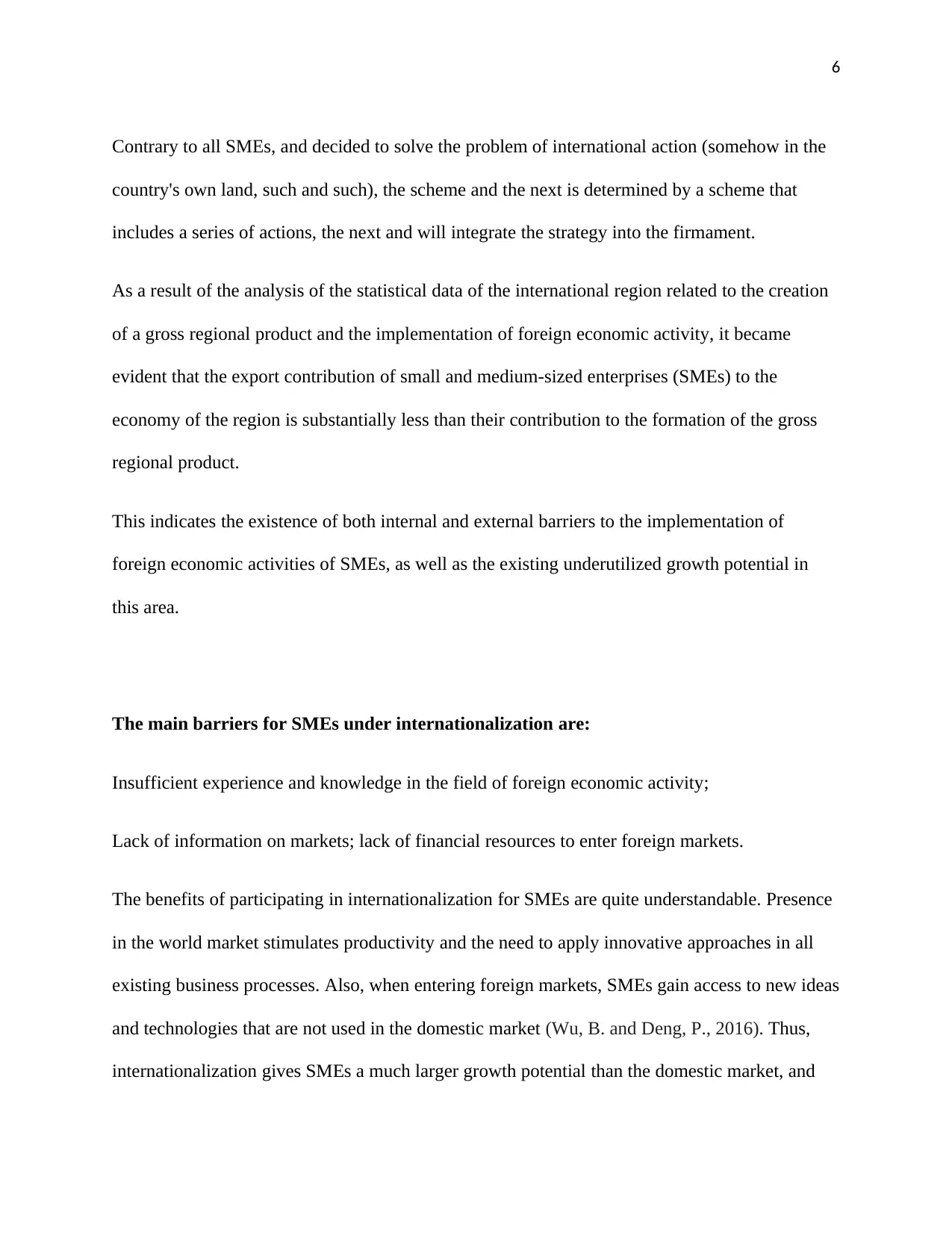
6
Contrary to all SMEs, and decided to solve the problem of international action (somehow in the
country's own land, such and such), the scheme and the next is determined by a scheme that
includes a series of actions, the next and will integrate the strategy into the firmament.
As a result of the analysis of the statistical data of the international region related to the creation
of a gross regional product and the implementation of foreign economic activity, it became
evident that the export contribution of small and medium-sized enterprises (SMEs) to the
economy of the region is substantially less than their contribution to the formation of the gross
regional product.
This indicates the existence of both internal and external barriers to the implementation of
foreign economic activities of SMEs, as well as the existing underutilized growth potential in
this area.
The main barriers for SMEs under internationalization are:
Insufficient experience and knowledge in the field of foreign economic activity;
Lack of information on markets; lack of financial resources to enter foreign markets.
The benefits of participating in internationalization for SMEs are quite understandable. Presence
in the world market stimulates productivity and the need to apply innovative approaches in all
existing business processes. Also, when entering foreign markets, SMEs gain access to new ideas
and technologies that are not used in the domestic market (Wu, B. and Deng, P., 2016). Thus,
internationalization gives SMEs a much larger growth potential than the domestic market, and
Contrary to all SMEs, and decided to solve the problem of international action (somehow in the
country's own land, such and such), the scheme and the next is determined by a scheme that
includes a series of actions, the next and will integrate the strategy into the firmament.
As a result of the analysis of the statistical data of the international region related to the creation
of a gross regional product and the implementation of foreign economic activity, it became
evident that the export contribution of small and medium-sized enterprises (SMEs) to the
economy of the region is substantially less than their contribution to the formation of the gross
regional product.
This indicates the existence of both internal and external barriers to the implementation of
foreign economic activities of SMEs, as well as the existing underutilized growth potential in
this area.
The main barriers for SMEs under internationalization are:
Insufficient experience and knowledge in the field of foreign economic activity;
Lack of information on markets; lack of financial resources to enter foreign markets.
The benefits of participating in internationalization for SMEs are quite understandable. Presence
in the world market stimulates productivity and the need to apply innovative approaches in all
existing business processes. Also, when entering foreign markets, SMEs gain access to new ideas
and technologies that are not used in the domestic market (Wu, B. and Deng, P., 2016). Thus,
internationalization gives SMEs a much larger growth potential than the domestic market, and
⊘ This is a preview!⊘
Do you want full access?
Subscribe today to unlock all pages.

Trusted by 1+ million students worldwide
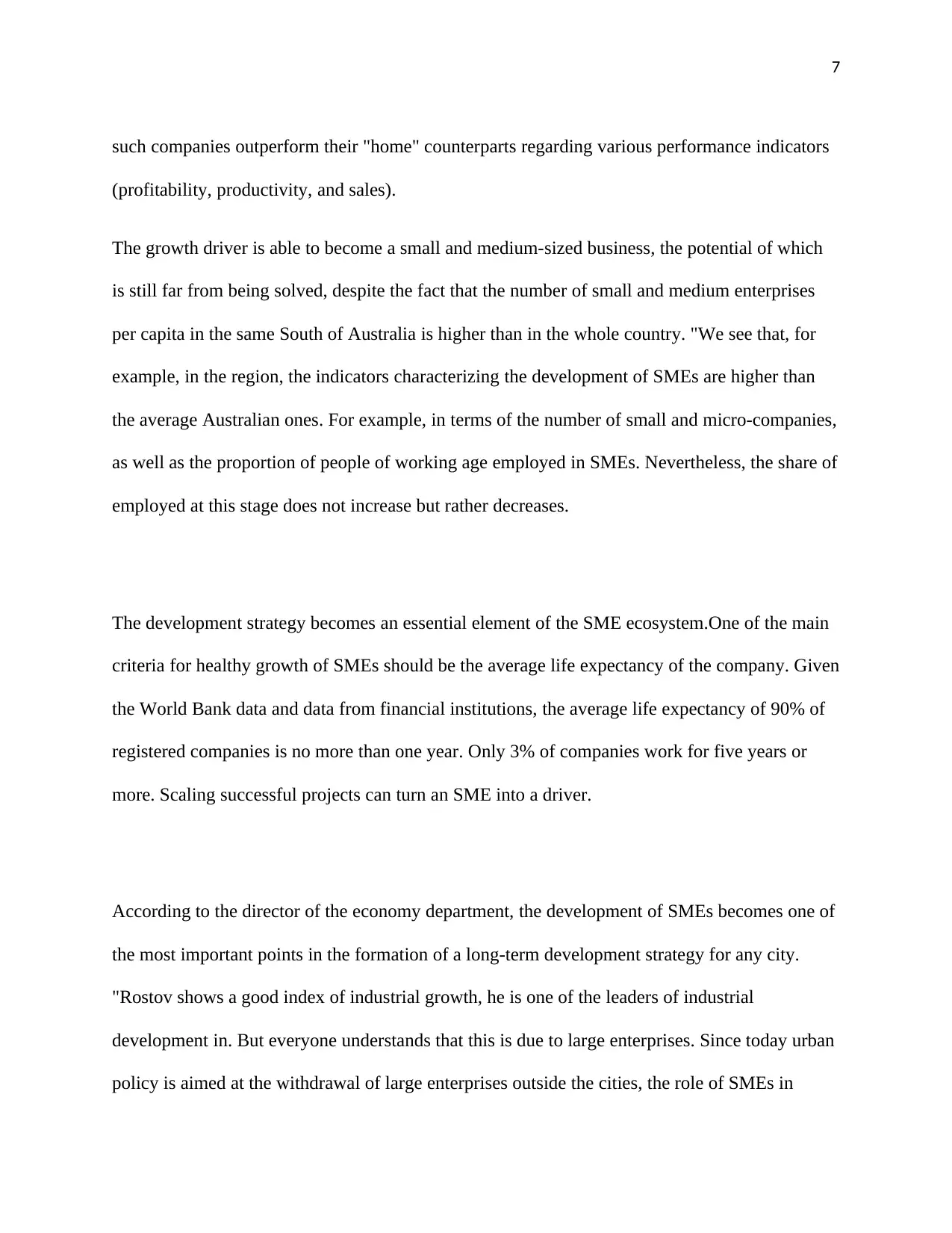
7
such companies outperform their "home" counterparts regarding various performance indicators
(profitability, productivity, and sales).
The growth driver is able to become a small and medium-sized business, the potential of which
is still far from being solved, despite the fact that the number of small and medium enterprises
per capita in the same South of Australia is higher than in the whole country. "We see that, for
example, in the region, the indicators characterizing the development of SMEs are higher than
the average Australian ones. For example, in terms of the number of small and micro-companies,
as well as the proportion of people of working age employed in SMEs. Nevertheless, the share of
employed at this stage does not increase but rather decreases.
The development strategy becomes an essential element of the SME ecosystem.One of the main
criteria for healthy growth of SMEs should be the average life expectancy of the company. Given
the World Bank data and data from financial institutions, the average life expectancy of 90% of
registered companies is no more than one year. Only 3% of companies work for five years or
more. Scaling successful projects can turn an SME into a driver.
According to the director of the economy department, the development of SMEs becomes one of
the most important points in the formation of a long-term development strategy for any city.
"Rostov shows a good index of industrial growth, he is one of the leaders of industrial
development in. But everyone understands that this is due to large enterprises. Since today urban
policy is aimed at the withdrawal of large enterprises outside the cities, the role of SMEs in
such companies outperform their "home" counterparts regarding various performance indicators
(profitability, productivity, and sales).
The growth driver is able to become a small and medium-sized business, the potential of which
is still far from being solved, despite the fact that the number of small and medium enterprises
per capita in the same South of Australia is higher than in the whole country. "We see that, for
example, in the region, the indicators characterizing the development of SMEs are higher than
the average Australian ones. For example, in terms of the number of small and micro-companies,
as well as the proportion of people of working age employed in SMEs. Nevertheless, the share of
employed at this stage does not increase but rather decreases.
The development strategy becomes an essential element of the SME ecosystem.One of the main
criteria for healthy growth of SMEs should be the average life expectancy of the company. Given
the World Bank data and data from financial institutions, the average life expectancy of 90% of
registered companies is no more than one year. Only 3% of companies work for five years or
more. Scaling successful projects can turn an SME into a driver.
According to the director of the economy department, the development of SMEs becomes one of
the most important points in the formation of a long-term development strategy for any city.
"Rostov shows a good index of industrial growth, he is one of the leaders of industrial
development in. But everyone understands that this is due to large enterprises. Since today urban
policy is aimed at the withdrawal of large enterprises outside the cities, the role of SMEs in
Paraphrase This Document
Need a fresh take? Get an instant paraphrase of this document with our AI Paraphraser
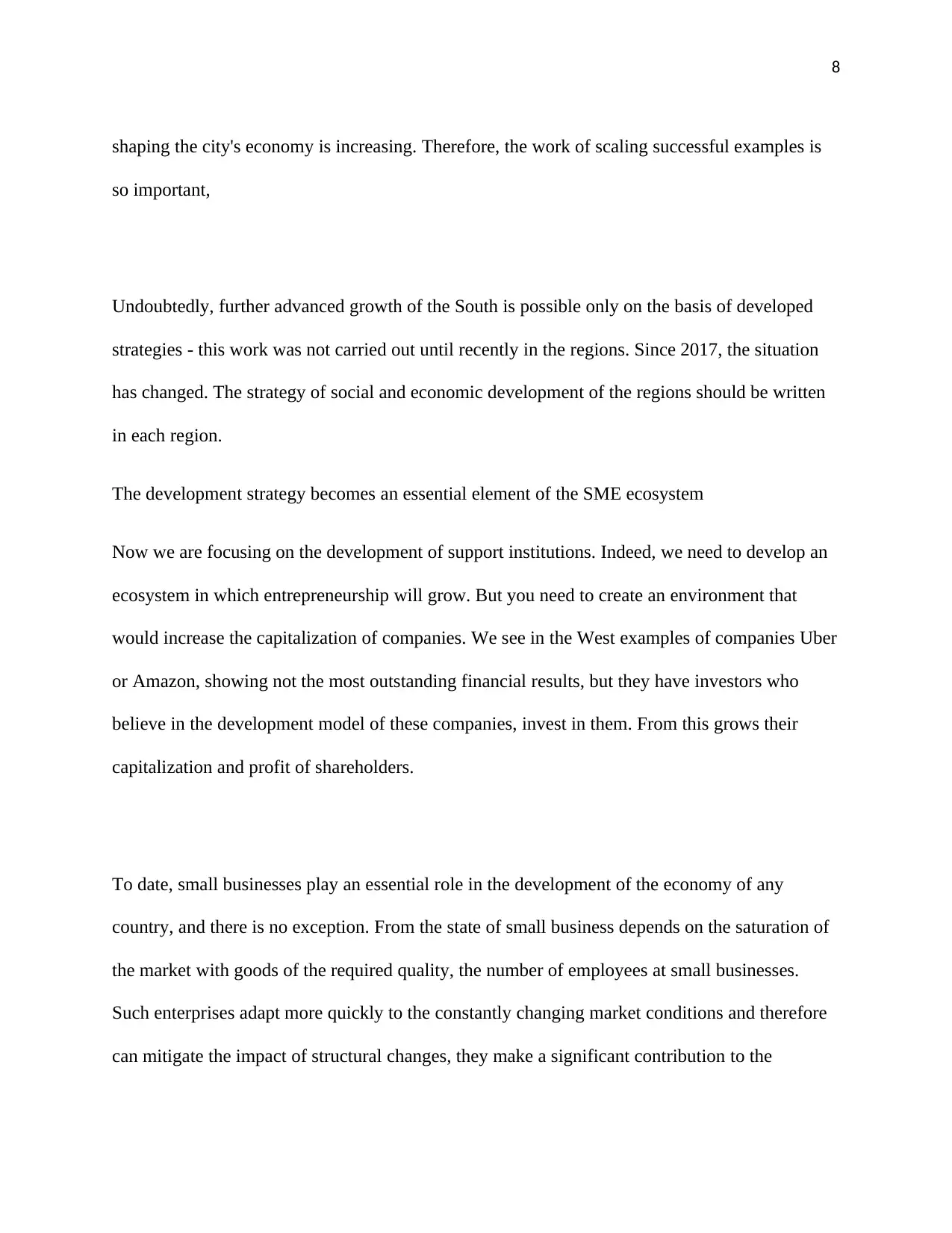
8
shaping the city's economy is increasing. Therefore, the work of scaling successful examples is
so important,
Undoubtedly, further advanced growth of the South is possible only on the basis of developed
strategies - this work was not carried out until recently in the regions. Since 2017, the situation
has changed. The strategy of social and economic development of the regions should be written
in each region.
The development strategy becomes an essential element of the SME ecosystem
Now we are focusing on the development of support institutions. Indeed, we need to develop an
ecosystem in which entrepreneurship will grow. But you need to create an environment that
would increase the capitalization of companies. We see in the West examples of companies Uber
or Amazon, showing not the most outstanding financial results, but they have investors who
believe in the development model of these companies, invest in them. From this grows their
capitalization and profit of shareholders.
To date, small businesses play an essential role in the development of the economy of any
country, and there is no exception. From the state of small business depends on the saturation of
the market with goods of the required quality, the number of employees at small businesses.
Such enterprises adapt more quickly to the constantly changing market conditions and therefore
can mitigate the impact of structural changes, they make a significant contribution to the
shaping the city's economy is increasing. Therefore, the work of scaling successful examples is
so important,
Undoubtedly, further advanced growth of the South is possible only on the basis of developed
strategies - this work was not carried out until recently in the regions. Since 2017, the situation
has changed. The strategy of social and economic development of the regions should be written
in each region.
The development strategy becomes an essential element of the SME ecosystem
Now we are focusing on the development of support institutions. Indeed, we need to develop an
ecosystem in which entrepreneurship will grow. But you need to create an environment that
would increase the capitalization of companies. We see in the West examples of companies Uber
or Amazon, showing not the most outstanding financial results, but they have investors who
believe in the development model of these companies, invest in them. From this grows their
capitalization and profit of shareholders.
To date, small businesses play an essential role in the development of the economy of any
country, and there is no exception. From the state of small business depends on the saturation of
the market with goods of the required quality, the number of employees at small businesses.
Such enterprises adapt more quickly to the constantly changing market conditions and therefore
can mitigate the impact of structural changes, they make a significant contribution to the
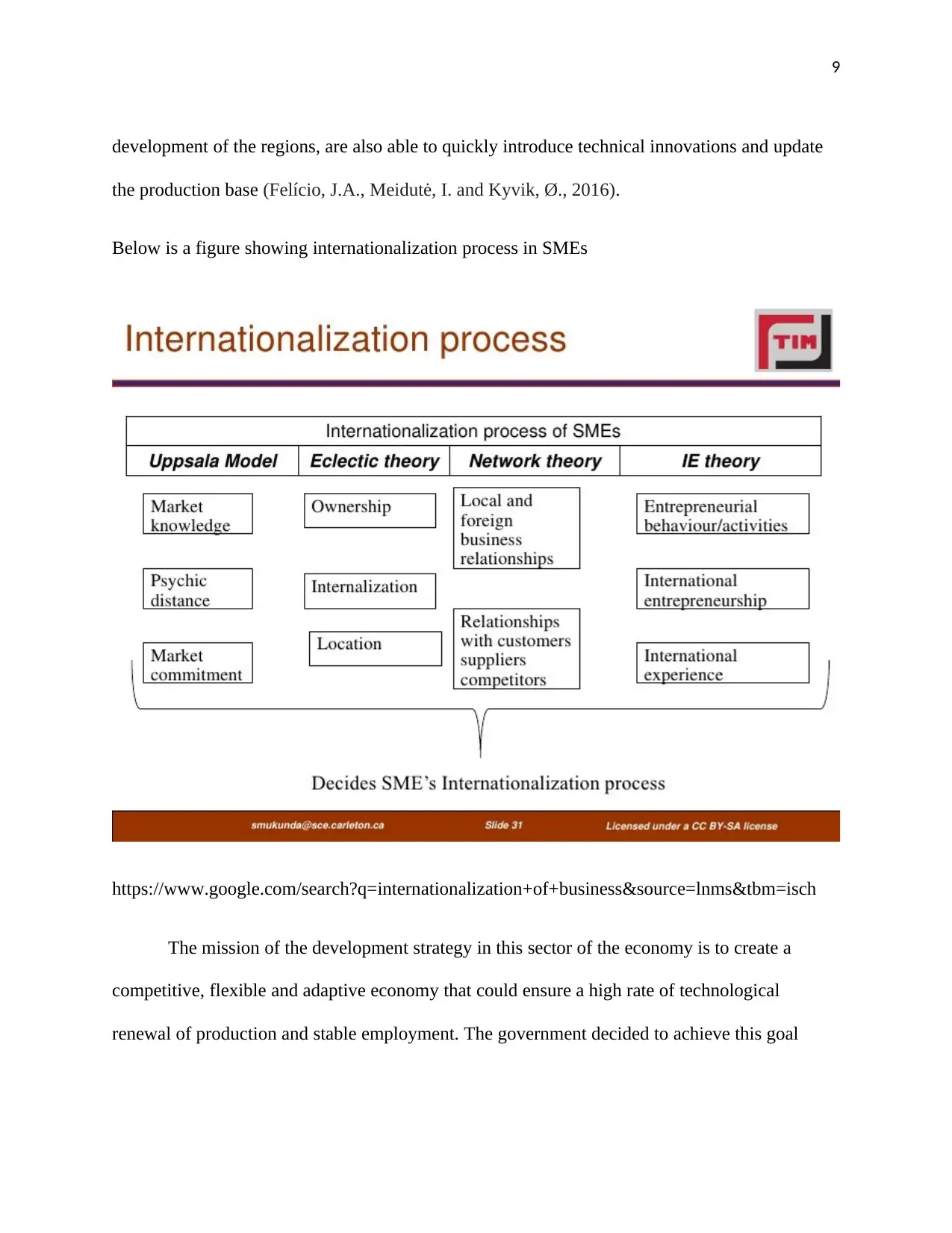
9
development of the regions, are also able to quickly introduce technical innovations and update
the production base (Felício, J.A., Meidutė, I. and Kyvik, Ø., 2016).
Below is a figure showing internationalization process in SMEs
https://www.google.com/search?q=internationalization+of+business&source=lnms&tbm=isch
The mission of the development strategy in this sector of the economy is to create a
competitive, flexible and adaptive economy that could ensure a high rate of technological
renewal of production and stable employment. The government decided to achieve this goal
development of the regions, are also able to quickly introduce technical innovations and update
the production base (Felício, J.A., Meidutė, I. and Kyvik, Ø., 2016).
Below is a figure showing internationalization process in SMEs
https://www.google.com/search?q=internationalization+of+business&source=lnms&tbm=isch
The mission of the development strategy in this sector of the economy is to create a
competitive, flexible and adaptive economy that could ensure a high rate of technological
renewal of production and stable employment. The government decided to achieve this goal
⊘ This is a preview!⊘
Do you want full access?
Subscribe today to unlock all pages.

Trusted by 1+ million students worldwide
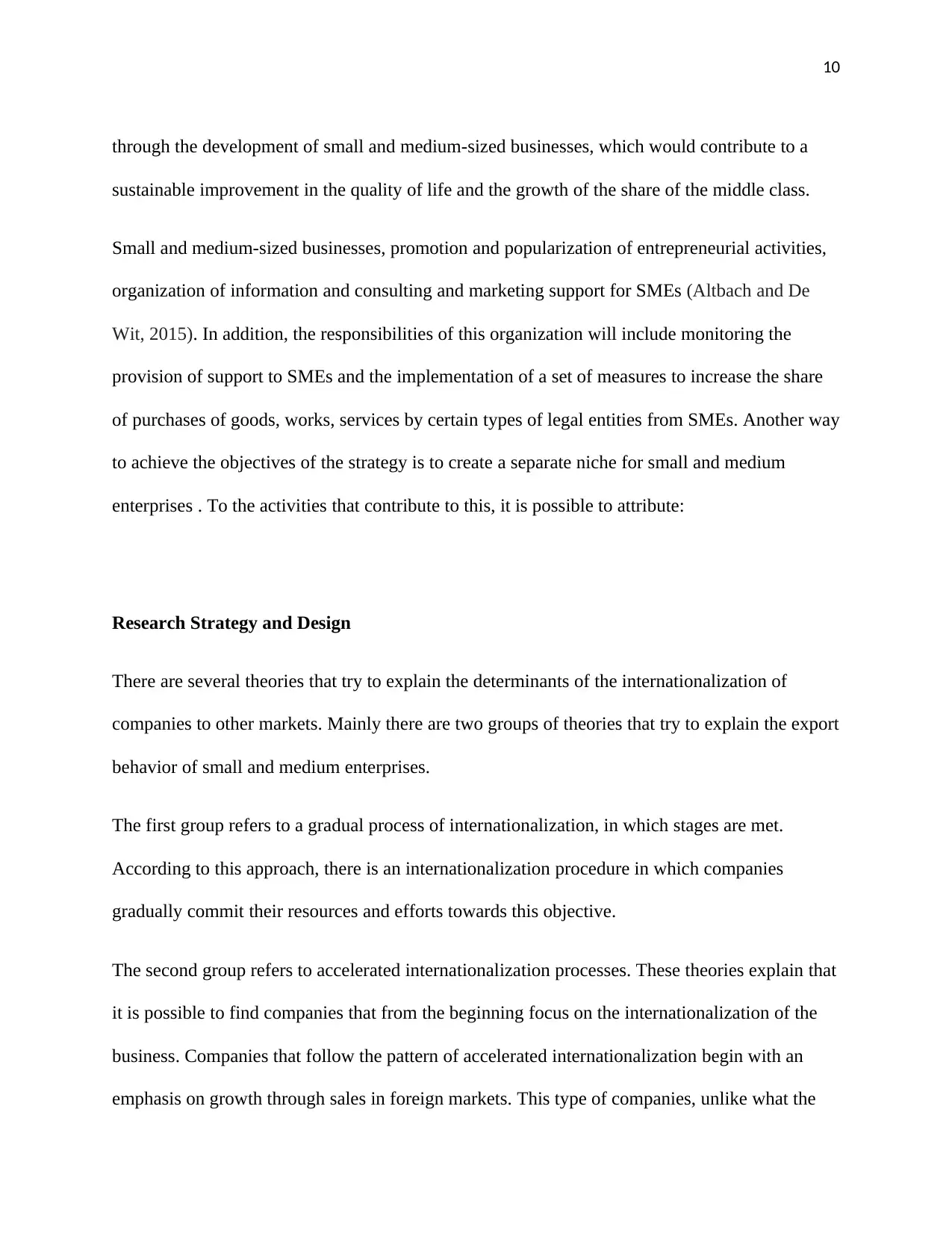
10
through the development of small and medium-sized businesses, which would contribute to a
sustainable improvement in the quality of life and the growth of the share of the middle class.
Small and medium-sized businesses, promotion and popularization of entrepreneurial activities,
organization of information and consulting and marketing support for SMEs (Altbach and De
Wit, 2015). In addition, the responsibilities of this organization will include monitoring the
provision of support to SMEs and the implementation of a set of measures to increase the share
of purchases of goods, works, services by certain types of legal entities from SMEs. Another way
to achieve the objectives of the strategy is to create a separate niche for small and medium
enterprises . To the activities that contribute to this, it is possible to attribute:
Research Strategy and Design
There are several theories that try to explain the determinants of the internationalization of
companies to other markets. Mainly there are two groups of theories that try to explain the export
behavior of small and medium enterprises.
The first group refers to a gradual process of internationalization, in which stages are met.
According to this approach, there is an internationalization procedure in which companies
gradually commit their resources and efforts towards this objective.
The second group refers to accelerated internationalization processes. These theories explain that
it is possible to find companies that from the beginning focus on the internationalization of the
business. Companies that follow the pattern of accelerated internationalization begin with an
emphasis on growth through sales in foreign markets. This type of companies, unlike what the
through the development of small and medium-sized businesses, which would contribute to a
sustainable improvement in the quality of life and the growth of the share of the middle class.
Small and medium-sized businesses, promotion and popularization of entrepreneurial activities,
organization of information and consulting and marketing support for SMEs (Altbach and De
Wit, 2015). In addition, the responsibilities of this organization will include monitoring the
provision of support to SMEs and the implementation of a set of measures to increase the share
of purchases of goods, works, services by certain types of legal entities from SMEs. Another way
to achieve the objectives of the strategy is to create a separate niche for small and medium
enterprises . To the activities that contribute to this, it is possible to attribute:
Research Strategy and Design
There are several theories that try to explain the determinants of the internationalization of
companies to other markets. Mainly there are two groups of theories that try to explain the export
behavior of small and medium enterprises.
The first group refers to a gradual process of internationalization, in which stages are met.
According to this approach, there is an internationalization procedure in which companies
gradually commit their resources and efforts towards this objective.
The second group refers to accelerated internationalization processes. These theories explain that
it is possible to find companies that from the beginning focus on the internationalization of the
business. Companies that follow the pattern of accelerated internationalization begin with an
emphasis on growth through sales in foreign markets. This type of companies, unlike what the
Paraphrase This Document
Need a fresh take? Get an instant paraphrase of this document with our AI Paraphraser
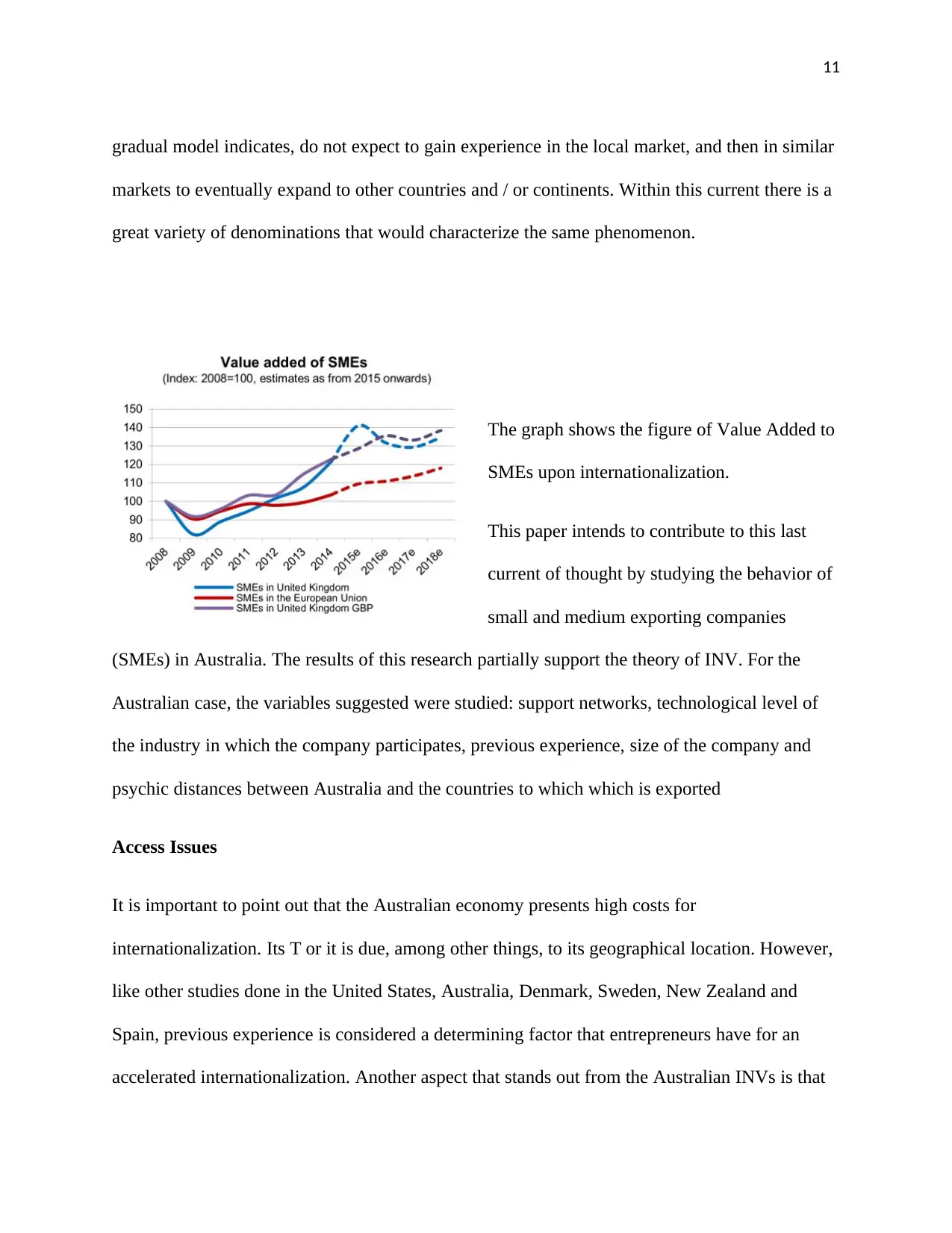
11
gradual model indicates, do not expect to gain experience in the local market, and then in similar
markets to eventually expand to other countries and / or continents. Within this current there is a
great variety of denominations that would characterize the same phenomenon.
The graph shows the figure of Value Added to
SMEs upon internationalization.
This paper intends to contribute to this last
current of thought by studying the behavior of
small and medium exporting companies
(SMEs) in Australia. The results of this research partially support the theory of INV. For the
Australian case, the variables suggested were studied: support networks, technological level of
the industry in which the company participates, previous experience, size of the company and
psychic distances between Australia and the countries to which which is exported
Access Issues
It is important to point out that the Australian economy presents high costs for
internationalization. Its T or it is due, among other things, to its geographical location. However,
like other studies done in the United States, Australia, Denmark, Sweden, New Zealand and
Spain, previous experience is considered a determining factor that entrepreneurs have for an
accelerated internationalization. Another aspect that stands out from the Australian INVs is that
gradual model indicates, do not expect to gain experience in the local market, and then in similar
markets to eventually expand to other countries and / or continents. Within this current there is a
great variety of denominations that would characterize the same phenomenon.
The graph shows the figure of Value Added to
SMEs upon internationalization.
This paper intends to contribute to this last
current of thought by studying the behavior of
small and medium exporting companies
(SMEs) in Australia. The results of this research partially support the theory of INV. For the
Australian case, the variables suggested were studied: support networks, technological level of
the industry in which the company participates, previous experience, size of the company and
psychic distances between Australia and the countries to which which is exported
Access Issues
It is important to point out that the Australian economy presents high costs for
internationalization. Its T or it is due, among other things, to its geographical location. However,
like other studies done in the United States, Australia, Denmark, Sweden, New Zealand and
Spain, previous experience is considered a determining factor that entrepreneurs have for an
accelerated internationalization. Another aspect that stands out from the Australian INVs is that
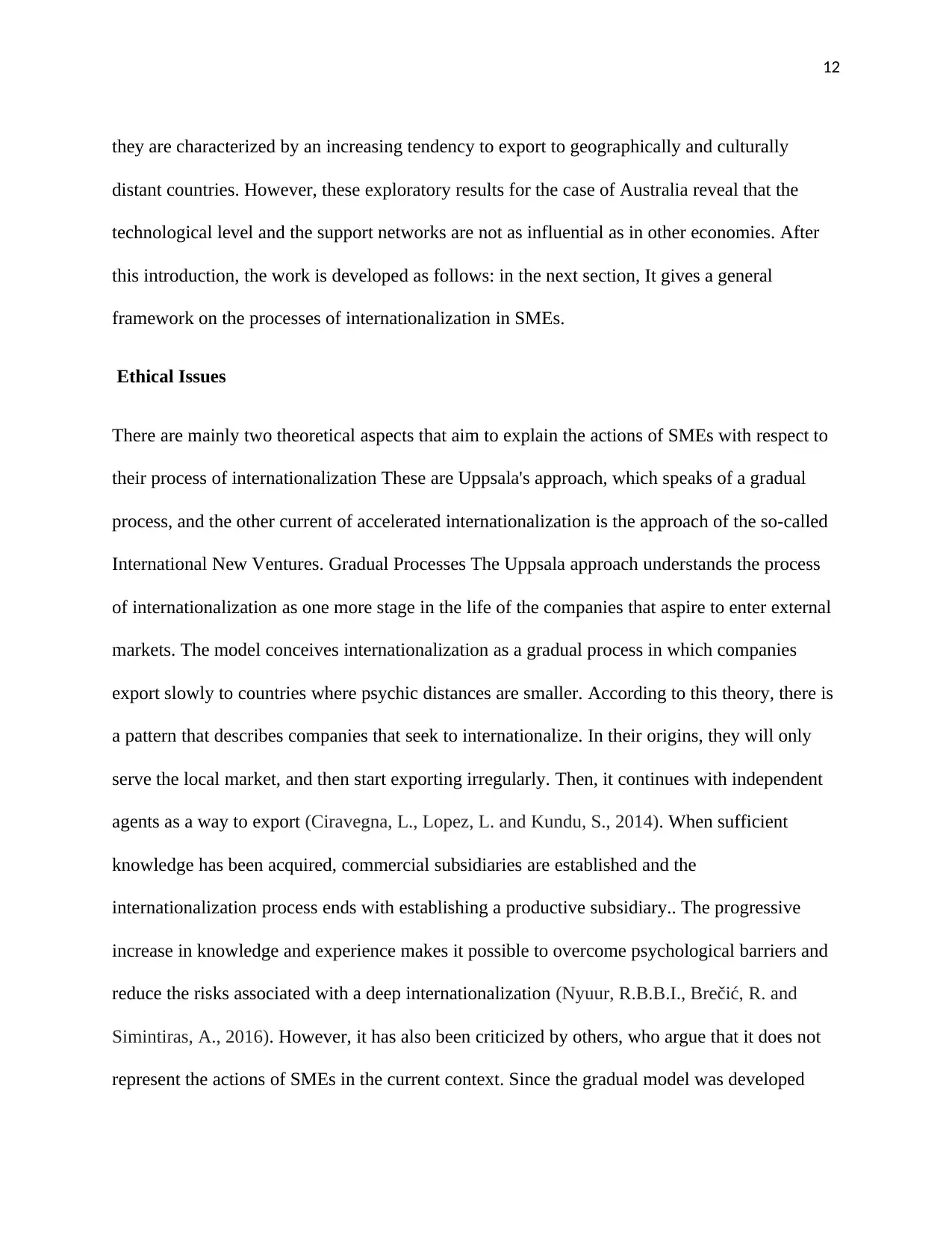
12
they are characterized by an increasing tendency to export to geographically and culturally
distant countries. However, these exploratory results for the case of Australia reveal that the
technological level and the support networks are not as influential as in other economies. After
this introduction, the work is developed as follows: in the next section, It gives a general
framework on the processes of internationalization in SMEs.
Ethical Issues
There are mainly two theoretical aspects that aim to explain the actions of SMEs with respect to
their process of internationalization These are Uppsala's approach, which speaks of a gradual
process, and the other current of accelerated internationalization is the approach of the so-called
International New Ventures. Gradual Processes The Uppsala approach understands the process
of internationalization as one more stage in the life of the companies that aspire to enter external
markets. The model conceives internationalization as a gradual process in which companies
export slowly to countries where psychic distances are smaller. According to this theory, there is
a pattern that describes companies that seek to internationalize. In their origins, they will only
serve the local market, and then start exporting irregularly. Then, it continues with independent
agents as a way to export (Ciravegna, L., Lopez, L. and Kundu, S., 2014). When sufficient
knowledge has been acquired, commercial subsidiaries are established and the
internationalization process ends with establishing a productive subsidiary.. The progressive
increase in knowledge and experience makes it possible to overcome psychological barriers and
reduce the risks associated with a deep internationalization (Nyuur, R.B.B.I., Brečić, R. and
Simintiras, A., 2016). However, it has also been criticized by others, who argue that it does not
represent the actions of SMEs in the current context. Since the gradual model was developed
they are characterized by an increasing tendency to export to geographically and culturally
distant countries. However, these exploratory results for the case of Australia reveal that the
technological level and the support networks are not as influential as in other economies. After
this introduction, the work is developed as follows: in the next section, It gives a general
framework on the processes of internationalization in SMEs.
Ethical Issues
There are mainly two theoretical aspects that aim to explain the actions of SMEs with respect to
their process of internationalization These are Uppsala's approach, which speaks of a gradual
process, and the other current of accelerated internationalization is the approach of the so-called
International New Ventures. Gradual Processes The Uppsala approach understands the process
of internationalization as one more stage in the life of the companies that aspire to enter external
markets. The model conceives internationalization as a gradual process in which companies
export slowly to countries where psychic distances are smaller. According to this theory, there is
a pattern that describes companies that seek to internationalize. In their origins, they will only
serve the local market, and then start exporting irregularly. Then, it continues with independent
agents as a way to export (Ciravegna, L., Lopez, L. and Kundu, S., 2014). When sufficient
knowledge has been acquired, commercial subsidiaries are established and the
internationalization process ends with establishing a productive subsidiary.. The progressive
increase in knowledge and experience makes it possible to overcome psychological barriers and
reduce the risks associated with a deep internationalization (Nyuur, R.B.B.I., Brečić, R. and
Simintiras, A., 2016). However, it has also been criticized by others, who argue that it does not
represent the actions of SMEs in the current context. Since the gradual model was developed
⊘ This is a preview!⊘
Do you want full access?
Subscribe today to unlock all pages.

Trusted by 1+ million students worldwide
1 out of 19
Related Documents
Your All-in-One AI-Powered Toolkit for Academic Success.
+13062052269
info@desklib.com
Available 24*7 on WhatsApp / Email
![[object Object]](/_next/static/media/star-bottom.7253800d.svg)
Unlock your academic potential
Copyright © 2020–2025 A2Z Services. All Rights Reserved. Developed and managed by ZUCOL.





